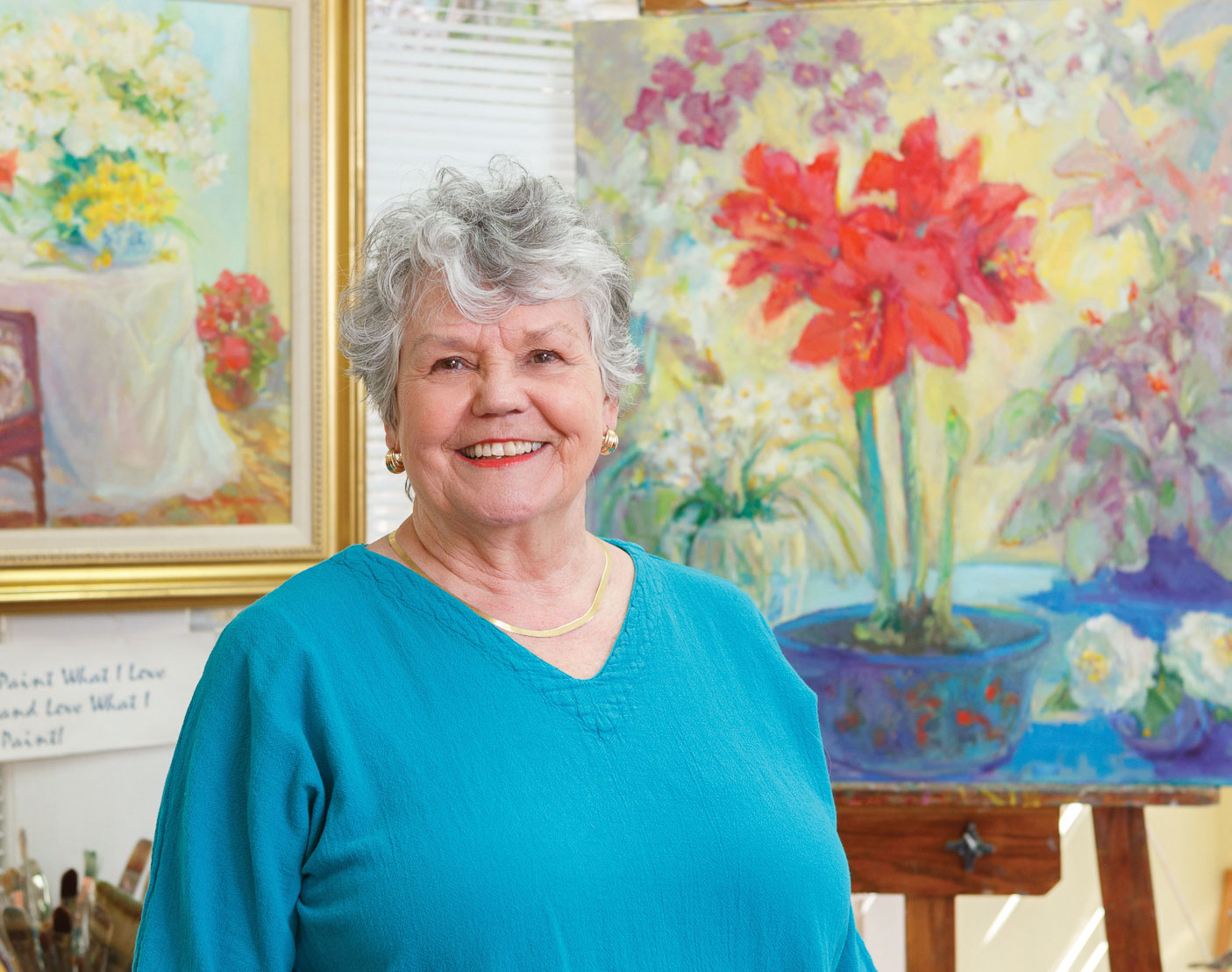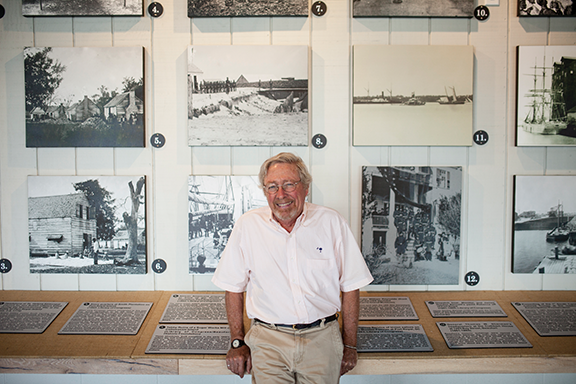Sandra Baggette, Painting What She Loves
It may be cold and rainy outside, but step into Sandra Baggette’s
house or studio and you will find yourself in a sunny garden, no
matter what the weather. The walls are bright with color, and
covering those walls are painting after painting of riotous flowers
blooming everywhere. The porch floor is a deep turquoise that picks
up the same shade, through the French doors, on a hutch inside the
house. Listen to her name the colors on her palette: radiant yellow,
light cadmium yellow, medium cadmium yellow, cadmium red light,
alizarin crimson, quinacridone violet, carbazole violet, platinum
violet, ultramarine blue, cobalt blue, cerulean blue, thalo blue,
thalo green, viridian, sap green, green gold, cad green light,
permanent green. And the earth colors: yellow ochre, raw sienna,
burnt sienna, burnt umber, raw umber, Naples yellow, titanim white and
ivory black. She is seduced by the colors of her garden and of the
paint itself, and with her paintings she invites us to share the
experience.
Sandra is a master gardener and a painter of the gardens she
creates and the still-life vignettes she makes from the flowers she
grows. Asked which came first – the gardening or the painting – she
says both. As a child, Sandra lived next door to a church, and when
the flowers from last week’s alter pieces were discarded, she
collected them and distributed them to her neighbors’ bushes, so that
they would seem to be in bloom. As for the art, she was always
drawing, and when it was time to go to college, she studied art. She
never stopped, and has used the opportunities to travel afforded by
her husband’s career as a Marine Corps officer to continue learning,
studying with well-known instructors at the Scottsdale Artist School
in Arizona, and in workshops across the United States, most especially
with S. Burket Kaiser, Ovanes Berberian, and Gay Faulkenberry. These
three are all former students of Sergei Bongart, a Russian
Impressionist whom Sandra particularly admires. She is also an
admirer of artist Charles Reid, and has taken both watercolor and oil
painting from him. For a time, Sandra painted mostly in watercolor,
because it was easier to transport as she traveled around, but now
that she and her husband Jack have retired, she paints primarily in
oils, preferring their lush texture and saturated color as more
responsive to her subject.
Sandra’s work has been enhanced by travels to Hong Kong,
Bermuda, and Hawaii, and by sketching and painting locations of her
favorite artists in in Italy and in France. She even, with special
permission, set up her easel and painted in Monet’s garden. Actually,
she and a painter friend of hers shared permission. When the guard
came by, one waved the letter granting it, and the other waved the
envelope the letter came in. Which friend had the letter in the first
place? Only the two friends know.
One thing is certain: Sandra is an admirer and follower of
Monet. In her book, Painting What I Love, she quotes him, “More than
anything I must have flowers, always, always.” Like Monet, Sandra
paints from life, and when the weather complies, that means en plein
air – that is to say, outside in the gardens. When the weather turns
foul, she then retreats to one of her studios, and paints the flowers
she brings inside. Living in Beaufort, Sandra can always find
something in bloom in her gardens. Painting what she loves is part of
her motto, and by that Sandra has always meant painting her flowers,
the ideal subjects for her style. Sandra is what is called a
“painterly” painter, meaning that her paintings show the process of
her work, with visible brush strokes rendered loosely and exuberantly.
In fact, she calls herself a painterly colorist, and the term is
precise.
Painting out of doors as she does requires both discipline and
patience, she says, because light constantly changes and so does the
weather. But it is that changing light and its effect on the flowers
she loves that captures her imagination and fires her motivation to
paint. As she says, “For me, it’s essential to have a strong
connection with a subject to create an expressive painting. A deep
love of flowers is one of my earliest memories. So far as I’m
concerned, my subject chose me. “ It is that need for a strong
connection with her subject that led her to take both the Clemson
University Master Gardeners Program and the Lowcountry Institute at
Spring Island’s Naturalist Program, which she says has “deepened her
knowledge and appreciation of nature and gardening in ways that
enhance her work.” While she most often paints in her own garden,
Sandra also works in other locations, and sometimes with other artists
who are fellow members of the Lowcountry Plein Air Society or
participating along with her in the Plein Air Painters of America
Paint Outs in Bennington, Vermont and Old Lyme, Connecticut.
Occasionally, Sandra paints something besides flowers – our
beautiful marshes, colorful chairs or an outdoor gathering of people.
. When she does, she invests the same exuberant love of her subject
that she brings to her flowers, and even inanimate objects, like the
chair, seem imbued with life. She has exhibited in over 100 juried
shows in the United States, and won a number of awards. These include
(but are not limited to) Third place in the 2014 Beaufort Spring Art
Show, an Award of Merit at the 2011 Piccolo Spoleto for her series,
Seasonal Inspirations, from judge Juan Logan, acceptance into the 2009
Hilton Head Art League National Juried Show by Judge Craig Srebnik,
First Place for Among the Flowers in the Lowcountry Plein Art Society
Competition judged by Jack Morris, and an Award of Merit from Jonathan
Green at the Piccolo Spoleto Arts Festival in 2008.
Back to Sandra’s motto, which is so important to her that she
posts it in both her home studio, and the studio she maintains at
Atelier on Bay. It reads, “Paint what you love, and love what you
paint.” It is easy to see the proof of the first part, because her
love of her subject is obvious in her paintings. But it is also the
sheer joy of painting itself that drives her: “Ultimately I paint for
the sake of painting, losing myself in the process of reacting to what
I’m seeing and the sensations of mixing colors and brushing paint on a
surface.” And the second part of that motto is important, too. “Love
what you paint,” she says, is to remind herself to give her work her
own approval, because like most artists, she can fall into the trap of
criticizing her work as falling short of her vision. It’s a good
motto, because it’s hard to imagine that she could be falling very far
short. Sandra Baggette seems to put all of herself into her painting,
and happily for the rest of us, it shows.
story by katherine lang
photography by susan deloach




